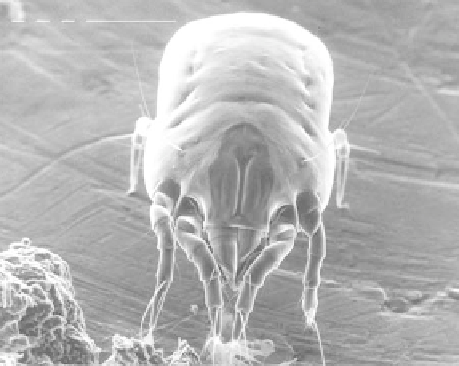Environmental Engineering Reference
In-Depth Information
Figure 5.3
Dust mite. (Courtesy of Arlian, L., Wright State University.)
Dust mites are relatively small and cannot be seen with the unaided eye.
Adult females of
D. farinae
are approximately 0.36 mm long and 0.43 mm
wide; females of
are somewhat smaller. A dust mite mag-
nified under a scanning electron microscope can be seen in
Figure 5.3
.
Dust mites, like their insect cousins, have multiple developmental stages.
These include egg, larva, several nymph stages, and ultimately the adult.
Each life cycle stage is characterized by an active feeding period, with qui-
escent periods between stages. A quiescent period of up to several months
for a dessication-resistant nymphal stage allows individuals to survive dry
conditions and contributes to the development of abundant mite populations
when building climatic conditions are more optimal. The lifetime of
D. pteronyssinus
females averages about 75 days; for
, 31 days. Dust mites
have significant microclimate requirements. Since they live in microenviron-
ments where no liquid water is present, they must extract water (by means
of specialized glands) from unsaturated air to compensate for body losses.
The maintenance of body fluid requirements and survival depends on the
relative humidity (not absolute humidity) of their surroundings. The critical
relative humidity for nonfeeding mites is approximately 70%. At relative
humidities of <55 to 60% they may dehydrate and die.
Because of high relative humidity requirements, mite populations are
small in desert or semiarid regions as well as at high altitudes or high
latitudes. They are, of course, very abundant in humid regions, and show
seasonal variability which coincides with changes in relative humidity. High
dust mite populations occur during humid seasons, as can be seen in
Figure
70% value. This reflects differences between inhabited microenvironments
and the surrounding building environment. Higher relative humidities may
occur in bedding and in carpeting near cooler floor surfaces.
D. pteronyssinus

